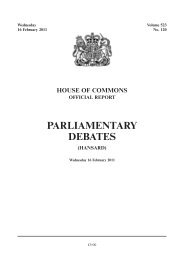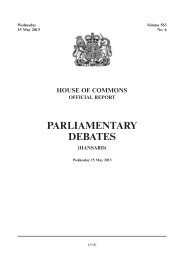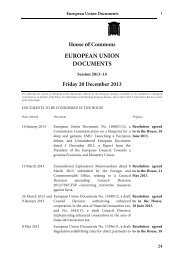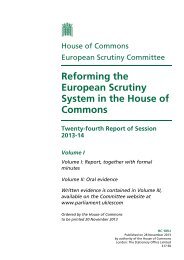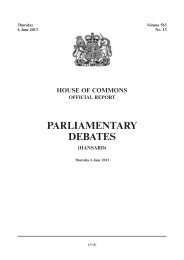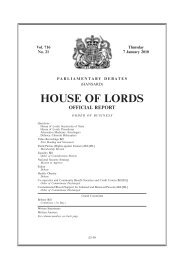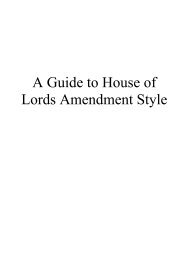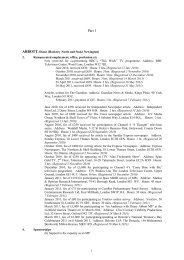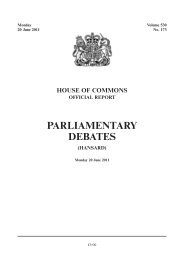- Page 1 and 2:
HOUSE OF LORDS Companion to the Sta
- Page 3:
PREFACE This is the 22nd edition of
- Page 6 and 7:
Secret sittings ...................
- Page 8 and 9:
Introduction and first reading.....
- Page 10 and 11:
Procedure on consideration of Commo
- Page 12 and 13:
Remedial orders ...................
- Page 14 and 15:
ABBREVIATIONS Erskine May Erskine M
- Page 16 and 17:
By the Act of Settlement 1701 1 “
- Page 18 and 19:
elected among the 15) in the releva
- Page 20 and 21:
no member of the House may act as s
- Page 22 and 23:
Leave of absence 1.27 Members of th
- Page 24 and 25:
announcement takes a standard form
- Page 26 and 27:
emunerated directorships and other
- Page 28 and 29:
Seating in the Chamber 1.54 The sid
- Page 30 and 31:
28 1. Throne 2. Cloth of Estate 3.
- Page 32 and 33:
CHAPTER 2 THE CROWN AND PARLIAMENTA
- Page 34 and 35:
2.09 A government backbencher also
- Page 36 and 37:
does not apply to a dissolution, wh
- Page 38 and 39:
Messages to members of the Royal Fa
- Page 40 and 41:
CHAPTER 3 SITTINGS AND DOCUMENTS OF
- Page 42 and 43:
Adjournment 3.09 At the end of busi
- Page 44 and 45:
Leave of the House 3.19 The leave o
- Page 46 and 47:
House of Lords Business 3.27 House
- Page 48 and 49:
oral questions, which may be tabled
- Page 50 and 51:
(c) business expressly exempted fro
- Page 52 and 53:
3.43 Private bills are entered on t
- Page 54 and 55:
e taken during the dinner break. On
- Page 56 and 57:
the remaining business from that si
- Page 58 and 59:
must submit a notification and expl
- Page 60 and 61:
papers can be found in the Handbook
- Page 62 and 63:
CHAPTER 4 CONDUCT IN THE HOUSE Self
- Page 64 and 65:
Any advice or assistance given by t
- Page 66 and 67:
Order of speaking 4.25 When two or
- Page 68 and 69:
4.33 There are reasons for these cu
- Page 70 and 71:
eferred to by their ministerial tit
- Page 72 and 73:
Law Officers of the Crown, Judges o
- Page 74 and 75:
the original motion as amended. It
- Page 76 and 77:
(c) Appellate proceedings, whether
- Page 78 and 79:
concerned can decide whether they c
- Page 80 and 81:
78 General principles 6. By virtue
- Page 82 and 83:
80 might be the case. Relevant inte
- Page 84 and 85:
itself once each Parliament, the Su
- Page 86 and 87:
5.14 Paragraphs 8(c) and 8(d) of th
- Page 88 and 89:
Registration 5.22 The Guide lists 1
- Page 90 and 91:
Use of facilities and services 5.32
- Page 92 and 93:
CHAPTER 6 STATEMENTS, QUESTIONS AND
- Page 94 and 95:
Publication in Hansard 6.08 Where a
- Page 96 and 97:
6.16 In drafting a question, though
- Page 98 and 99: Questions should not ask the govern
- Page 100 and 101: Secretary of State’s questions ar
- Page 102 and 103: The ballot for Secretary of State
- Page 104 and 105: or any other member to ensure that
- Page 106 and 107: Motions General 6.46 In a normal fu
- Page 108 and 109: egularly used for select committee
- Page 110 and 111: 6.63 If the number of speakers on t
- Page 112 and 113: Committees on motions 6.77 On rare
- Page 114 and 115: CHAPTER 7 DIVISIONS General princip
- Page 116 and 117: into two streams in each lobby. 1 T
- Page 118 and 119: division list in the Minutes of Pro
- Page 120 and 121: (f) on a motion to insist, or not t
- Page 122 and 123: The debate on the amendment and the
- Page 124 and 125: (c) on all bills of considerable le
- Page 126 and 127: Procedure on introduction: Lords bi
- Page 128 and 129: provisional order confirmation bill
- Page 130 and 131: Constitution Committee 8.35 The Con
- Page 132 and 133: Room. 1 Following first reading, a
- Page 134 and 135: advice when the amendment is called
- Page 136 and 137: amendments to insert a new clause a
- Page 138 and 139: of the House will not have had an o
- Page 140 and 141: Effect of groupings on third readin
- Page 142 and 143: ill without Question put either in
- Page 144 and 145: e resumed. The Lord in the Chair th
- Page 146 and 147: 8.102 Any bill may be committed to
- Page 150 and 151: the order may be discharged and an
- Page 152 and 153: Commons amendments) in Committee of
- Page 154 and 155: 8.139 Only the mover of an amendmen
- Page 156 and 157: Further proceedings after third rea
- Page 158 and 159: of the bill are no longer at issue,
- Page 160 and 161: 8.170 If the Commons amend the Lord
- Page 162 and 163: LORDS AMENDMENTS TO COMMONS BILLS 8
- Page 164 and 165: the original Lords amendment, which
- Page 166 and 167: Money bills 8.196 A money bill is a
- Page 168 and 169: Consolidation bills 8.204 Consolida
- Page 170 and 171: the Lords the committee stage of a
- Page 172 and 173: 8.222 The Measure is submitted firs
- Page 174 and 175: CHAPTER 9 PRIVATE LEGISLATION Role
- Page 176 and 177: with. 1 These standing orders requi
- Page 178 and 179: the case of bills originating in th
- Page 180 and 181: second reading. 1 Such bills are no
- Page 182 and 183: evidence from the parties and the r
- Page 184 and 185: e deposited by the promoter at cert
- Page 186 and 187: The petition must be signed by one
- Page 188 and 189: Scotland; and petitions him to issu
- Page 190 and 191: deemed to have been given for the s
- Page 192 and 193: proceeds in the Lords straight from
- Page 194 and 195: Types of delegated legislation 10.0
- Page 196 and 197: 10.10 A motion to approve an affirm
- Page 198 and 199:
on the government to take action or
- Page 200 and 201:
10.27 If however a scrutiny committ
- Page 202 and 203:
10.37 When the Chairman of Committe
- Page 204 and 205:
to orders made under Acts passed be
- Page 206 and 207:
10.53 If no resolution for annulmen
- Page 208 and 209:
or reserved matter unless he has la
- Page 210 and 211:
to any Member to table a free-stand
- Page 212 and 213:
laid a copy before Parliament; pub
- Page 214 and 215:
11.05 Certain committees are reappo
- Page 216 and 217:
Committee for Privileges and Conduc
- Page 218 and 219:
deliberate or to take evidence. Sel
- Page 220 and 221:
egular debates on select committee
- Page 222 and 223:
Legislative and Regulatory Reform A
- Page 224 and 225:
consider the merits or policy of de
- Page 226 and 227:
of eleven members of the House, inc
- Page 228 and 229:
House, including membership of any
- Page 230 and 231:
CHAPTER 12 PARLIAMENTARY PRIVILEGE
- Page 232 and 233:
any form of molestation of, or inte
- Page 234 and 235:
have arisen in only two cases in th
- Page 236 and 237:
DATA PROTECTION 12.22 The Data Prot
- Page 238 and 239:
APPENDIX A DIVISIONS: INSTRUCTIONS
- Page 240 and 241:
238 (f) Any visitor who is suspecte
- Page 242 and 243:
Summoning the Commons The presiding
- Page 244 and 245:
Then the presiding Commissioner say
- Page 246 and 247:
place the most favourable construct
- Page 248 and 249:
presence of the Sovereign. This was
- Page 250 and 251:
APPENDIX F ROYAL ASSENT BY COMMISSI
- Page 252 and 253:
APPENDIX G PROROGATION BY COMMISSIO
- Page 254 and 255:
APPENDIX H ENDORSEMENTS TO BILLS Lo
- Page 256 and 257:
we thine unworthy servants, here ga
- Page 258 and 259:
The Reading Clerk reads the Letters
- Page 260 and 261:
APPENDIX L SCRUTINY RESERVE RESOLUT
- Page 262 and 263:
INDEX absence of member asking ques
- Page 264 and 265:
annulment equality of votes, 118 of
- Page 266 and 267:
pre-legislative scrutiny, 128 print
- Page 268 and 269:
Committee of Selection, 225 Committ
- Page 270 and 271:
demise of the Crown, 34 oath to be
- Page 272 and 273:
financial privilege. see Commons fi
- Page 274 and 275:
maiden speeches, 68 intervals, mini
- Page 276 and 277:
memorials complaining of non-compli
- Page 278 and 279:
entitlement of members to, 56 may n
- Page 280 and 281:
Privileges and Conduct, Committee f
- Page 282 and 283:
ules of debate, 151 Representation
- Page 284 and 285:
Sewel motion. see Scottish Parliame
- Page 286 and 287:
Joint Committee on, 168 tax status
- Page 289:
ISBN 978 0 10 847241 1 £13.50



